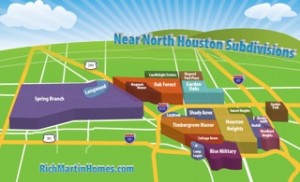Houston Chronicle Article on the Heights (Part 2)
Heights Blends Old and New (Part 2 of 2)
A modification of this post was published in the Houston Chronicle on 01/09/11. It was only published in their print edition, not online:
House Styles in the Heights
Houston Heights was started in the 1890’s. The predominant house style at that time was the Victorian. The most common sub-type was the Queen Anne. The Queen Anne was a status symbol. Everything about it said “excess”; two stories, with extremely pitched roofs soaring upward. Lots of towers, turrets, porches, overhanging balconies, protruding bay windows, decorative trim. Small, chopped up richly detailed rooms, elaborate banisters. Many beautiful examples are still on Heights Blvd, along with new homes with the same period look.
There were smaller, less fanciful versions built away from the boulevard.
The style that came into vogue after 1900 was the Craftsman style. This style was born out of the Arts and Crafts movement as a reaction against the Victorian movement. The Craftsman bungalow is the most common of these. Not ornate; simplicity of style and construction. Square sturdy columns, not ornate turned spindles. Low slung roofs and horizontal lines with large overhanging eaves, simple exposed rafter tails.
Woodland Heights, where I live, was started in 1907. Thus predominant style here is the Craftsman bungalow. I bought my house 20 years ago because of the porch. The house was falling down, but I loved that wrap-around porch, and massive square columns. These are simple, comforting homes with fireplace, flanking bookcases.
These were inexpensive homes to build, just involving basic carpentry. In fact Woodland Heights/Norhill has several homes built from Sears Roebuck catalog kits. For $1500-$2500 you could have a kit delivered to your lot with pre-numbered lumber, doors, windows, plumbing and electrical fixtures. Everything you need to assemble a house.
Bungalows and cottages continued to be popular into the 1930’s when the Heights was mainly filled in.
Because of land prices, the most commonly built home now is the tall skinny Victorian, or a Craftsman-inspired home on a narrow lot. Land costs too much to spread out a one story bungalow.
What you don’t see too much of are townhomes. There are older groups scattered around, and a few new developments around the outskirts, where land is cheaper. Garage-front homes are getting more common (again, less costly because they use less land) but again, more on the edges. These are typically built on the odd locations, where big new construction would be over-priced.
Price Range of Homes in the Heights
House prices inside the 610 Loop are driven by land prices. A beautifully restored 1920’s 3/2 home, around 1500SF is in the range of $350-$400K.
The little 2/1 bungalow is in the range of $250-300K. These are 50 ft wide lots and range from 100 to 132 ft deep. Since vacant lots sell from $30-40/SF (Woodland heights, Norhill, premier streets of Houston Heights command the upper end) lot prices are $200-260K, you are paying mainly for the land.
New construction prices depend on lot size. Single family “Heights style” homes on 25 foot wide lots are in the mid $400’s for 2200 SF 3/2.5/2. Larger lots hold bigger houses. Thus new homes on 50 ft wide lots are in the range of $600-$975K. These are obviously in the more desirable areas.
Sale volumes are down since the recession of course, but prices remain strong. One big change though is in the number of new homes being built. New homes 2 years ago accounted for 30% of sales. They are half of that now. It is just tough for builders to get loans.
Notes:
Rich Martin is a Heights realtor whose degree is in chemistry. He remodeled an old house in the Heights for “fun & profit” many years ago. He then fell in love with the area and began selling these wonderful old homes. He now specializes in new homes and restored homes in the Heights and other close-in areas.
See pages on individual older neighborhoods by clicking on Area Tabs. An example is page on Houston Heights.












